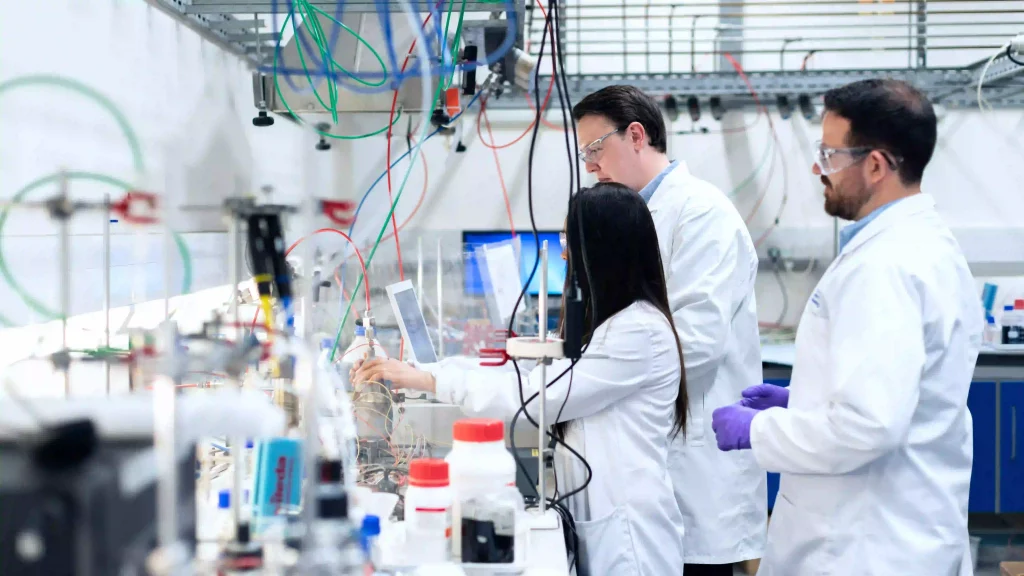
“Without a repeatable process, improving our understanding of nanoparticles is like learning to shoot basketball hoops where the hoop and the ball are a difference size and shape each time”
The Cross-Cluster Proof of Concept grant, funded by UKRI-STFC, is targeted at collaborative research and development, with a multidisciplinary remit that encourages industry to engage with other organisations in short term innovative projects. Over the last three years at Harwell Campus there have been 31 projects, with 21 companies collaborating with 29 organisations. We met with the team behind the Nanowire Grid Quantification Project, a recipient of the grant for 2019/20, to learn about what has been achieved and why.
In a bid to visualise and measure the parameters of nanowire grids used in cryo-electron microscopy, three agencies collaborated on campus as part of the Proof of Concept programme. Over the course of several months, Borwell, The Rosalind Franklin Institute and 3Dmagination worked to advance our understanding of these nanostructure materials that wick away excess solution in a controlled way before vitrification – the rapid freezing of samples into a glass-like ice.
Mark Basham from the Rosalind Franklin Institute told us that the understanding of nanostructures holds huge potential for improvements in our development of technology in everything from biomedical applications to energy storage. Mark referenced a recent project on nanobodies from another Franklin team as an example:
“Llamas, camels and alpacas naturally produce quantities of small antibodies with a simpler structure than human antibodies. By engineering new nanobodies from a library of naturally occurring antibodies found in llama blood, the team has created nanobodies that bind tightly to the spike protein of the SARS-CoV-2 virus, blocking it from entering human cells and stopping infection.”
Mark Basham from the Rosalind Franklin Institute
The hope is that this technique could support passive immunisation for patients critically ill with COVID-19, or be used to create novel and rapid diagnostics.
Without an understanding of the structure of viruses and proteins associated with the disease, it is exceptionally difficult to create therapies. Knowing how to inhibit or activate proteins enables advances in, for instance, treatments for coronavirus or even cancer as the interactions between disease and drug treatments can be better tailored. Imaging techniques such as Cryo-EM are essential for this, as they enable detailed imaging of biological structures. The team carried out work to understand better the grids used to hold frozen samples during analysis. The technique of Cryo-EM requires significant expertise in sample creation and handling – something which the team aim to make easier and less variable for researchers in future.
The team set out to overcome the issue of a slow and difficult method of analysis by creating a new strategy involving machine learning and 2d microscopic photography.
We’ve all been at Harwell for many years and our collaboration is a prime example of how the campus works. borwell set up its Harwell office in the Satellite Catapult to access the space market and having been introduced to each other we realised we could apply machine learning to the health sector and that we should apply for the Cross Cluster Proof of Concept project. The really exciting thing is we’re dealing with a scenario that can be applied to other sectors from space and satellites to the energy market.
Marcus Ambler from Borwell on how the partnership came together.
Asked what, in their wildest dreams the progress they’ve made might lead to, Marcus said, “The scope of any future work carried out by Borwell, The Franklin & 3DMagination team is vast because we think we may be able to apply our collaborative practices and methods to a variety of disciplines. We are particularly excited to work on our understanding of how, with the right additional partners and sponsors, work on the treatment of cancer for example.”
In making strides towards that goal, the project has deployed machine learning to great effect and Mark Basham was at pains to point out the challenge inherent in teaching a machine to spot something that you don’t recognise yourself. “There is a widely held misunderstanding that Artificial Intelligence is a ‘silver bullet’ solution to a huge variety of scientific unknowns. In fact, teaching a computer to spot cats, or road signs, or whatever else is easy but teaching it to do research, to look at things we’ve never looked at before, is a completely different prospect.”
This is where the right combination of people and expertise is important. The extraction of relevant scientific information from the collected images is the foundation for high-quality training data, without which even the most performant algorithms can be useless.
Kamel Madi, representing 3Dmagination